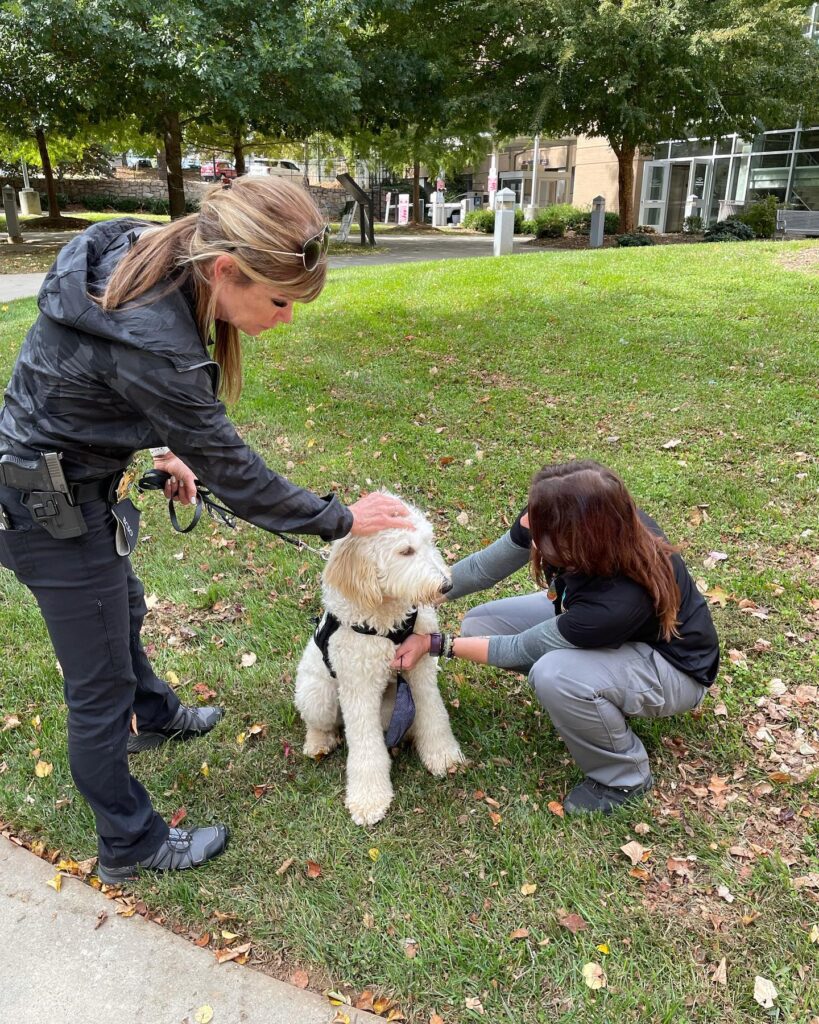Dogs have evolved to perform many important functions in our modern-day society. From providing assistance to those in need as service dogs, or through being trained to help law enforcement and military teams, dogs can be trained to help us in a variety of ways.
We all know that being in the presence of dogs brings an abundance of positive health benefits for humans – and this isn’t just a ‘feeling’, it is actually backed by scientific research! Interacting with dogs can increase the production of chemicals in our brain that make us feel happy, such as oxytocin, serotonin and dopamine.
One increasingly popular way to unleash these benefits in numerous public settings is through therapy dogs. In this article, we’ll look at what a therapy dog is, why they are beneficial, and where they can be utilized. We’ll also discuss how to determine if your dog is a good candidate for therapy dog work.
What is a therapy dog?
Put simply, a therapy dog is a dog that has been trained to provide comfort, reassurance and affection. Typically, a therapy dog’s handler will bring the dog to public places, such as hospitals, retirement homes or schools. The therapy dog will be made available for interaction, whether that entails being petted, laying next to or touching people with their paw, or simply being present as a calming influence.
Benefits of a therapy dog
There are numerous benefits for bringing therapy dogs into environments like schools or retirement homes, including the following examples:
- Providing a calm, reassuring presence for individuals suffering with stress or anxiety
- Increasing the confidence of shy or less confident children in a school setting, such as by laying next to a younger child trying to read a book
- Acting as a social bridge for children who struggle to make friends
- Improving the mood and mental health of individuals recuperating in hospitals
- Offering a focal point/distraction in the aftermath of a traumatic event, such as a natural disaster
Ultimately, there are a number of different situations in which a therapy dog can be utilized. The exact nature of their work will differ depending on the context in which they are operating in, but there are some traits that are essentially universal across all dogs used in therapy work.
Therapy dog requirements
There are no breed restrictions or requirements for therapy dogs. While some breeds may be more predisposed to therapy work, the judgment as to whether a dog is a good therapy dog candidate should be made based on the dog’s behavior and temperament.
Due to the nature of their role, a therapy dog must exhibit the following traits:
- Calm
- No behavioral concerns
- Clean and well-groomed
- Socially appropriate at all times
- Obedient and responds to commands
- Friendly and warm-hearted
- Well-mannered
Therapy dog uses
Therapy dogs can be used in all kinds of environments. Most commonly, they are used in hospitals to provide a friendly distraction for patients; in schools, to help children with activities like reading; or in retirement homes, to bring joy to older people.
However, there are a number of other ways that therapy dogs can be used. For example, police departments have used trained therapy dogs to provide reassurance to law enforcement officers. Some employers even encourage therapy dogs to be brought into the workplace to provide stress relief to their staff. The uses for therapy dogs simply depend on the needs of the organization that requires them.

Difference between therapy dogs and service dogs
There are some important differences between therapy dogs and service dogs. As with emotional support animals (ESAs), therapy dogs are often confused with service animals, but there are distinctions to be highlighted between these types of dogs.
A service dog is a dog that has been trained to perform specific tasks for an individual. There are legal rights that are enshrined in the Americans with Disabilities Act (ADA), protecting service dog owners from discrimination.
By contrast, a therapy dog has generalized behaviors that enable them to work with a variety of different people. However, they have not been trained to perform a specific task for an individual.
Therapy dogs (and ESAs for that matter) do not fall under the remit of the ADA. As such, therapy dogs are not afforded the same rights as service dogs. This is a significant difference between therapy dogs and service dogs, and one that is important to be aware of.
Can your dog be a therapy dog?
As a dog owner, you should be realistic about whether your dog is a suitable candidate for therapy dog work. The decision-making process isn’t as simple as “well, he’s usually pretty friendly, so I think he’d be a good fit”.
Many pet dogs, if they have undergone obedience training and have a friendly disposition, may certainly be candidates for therapy dog work. With that said, a therapy dog will naturally operate in environments where people may be struggling physically, mentally or emotionally. In the case of schools, many younger children may not be able to remain completely calm when interacting with your pup. While the intention to help should naturally be applauded, you should assess if your dog is truly a good fit.
Speaking with a professional dog trainer to assess your dog’s suitability for therapy dog work is a great starting point. You can also sign your dog up for classes like basic obedience group classes, the AKC Canine Good Citizen (CGC) program, or dedicated therapy dog classes. These classes will help to build a solid foundation of behavior which can also help you to decide if your dog will be suited to therapy dog work. They can also allow you to improve your skills when handling your pup.
If you are interested in understanding if your dog could be a good candidate for therapy dog work, reach out to one of our trainers today! Also, check out our calendar to see if we are running therapy dog classes in your area.
Related posts

Follow These Car Travel Safety Tips For Your Dog
Traveling with your dog in your car can be fun – but keeping them safe should be your top priority.

Why Dogs Are The Best Pets
Okay, so we all know that dogs are the best pets – but now we’ve collated the science and data to prove it.

New Puppy Checklist: Here’s What You Need
Bringing a new puppy home? Here’s the list of everything you’ll need to give your new pup the best start in life!


You must be logged in to post a comment.